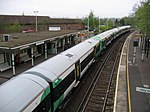East Grinstead

East Grinstead is a town in West Sussex, England, near the East Sussex, Surrey, and Kent borders, 27 miles (43 km) south of London, 21 miles (34 km) northeast of Brighton, and 38 miles (61 km) northeast of the county town of Chichester. Situated in the southeast of the county, the civil parish has an area of 2,443.45 hectares (6,037.9 acres). The population at the 2011 Census was 26,383.Nearby towns include Crawley and Horley to the west, Tunbridge Wells to the east and Redhill and Reigate to the northwest. The town is contiguous with the village of Felbridge to the northwest. Until 1974 East Grinstead was in East Sussex, before joining with Haywards Heath and Burgess Hill as the Mid-Sussex district of West Sussex. The town is on the Greenwich Meridian. It has many historic buildings, and the Weald and Ashdown Forest lie to the south-east.
Excerpt from the Wikipedia article East Grinstead (License: CC BY-SA 3.0, Authors, Images).East Grinstead
Lynton Park Avenue, Mid Sussex Ashplats
Geographical coordinates (GPS) Address Nearby Places Show on map
Geographical coordinates (GPS)
| Latitude | Longitude |
|---|---|
| N 51.13 ° | E 0 ° |
Address
Lynton Park Avenue
RH19 3XB Mid Sussex, Ashplats
England, United Kingdom
Open on Google Maps








